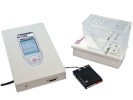Authors
E. Laboureyras, J. Chateauraynaud, P. Richebé, G. Simonnet.
Lab
Université Bordeaux 2, Université Bordeaux 1, CNRS UMR 5227, Bordeaux, France.
Journal
Anesthesia and Analgesia
Abstract
BACKGROUND: Tissue damage associated with surgery often produces peripheral and central sensitization that may outlast the stimuli, leading to exaggerated postoperative pain. Paradoxically, the use of opioid analgesia, which is essential for surgical pain management may induce pain sensitization leading to enhanced postoperative pain and an increased risk of developing chronic pain. We studied whether a surgical incision in the rat hindpaw may favor the development of long-term pain vulnerability by estimating hyperalgesia induced by an inflammatory stimulation of the unlesioned contralateral hindpaw 3 wk later. We also evaluated the ability of nefopam, an analgesic drug commonly used in postoperative pain management, to prevent not only exaggerated postoperative pain but also long-term pain vulnerability. The efficacy of morphine was assessed 1 day after surgical incision. METHODS: On Day 0, a surgical plantar incision was performed in one hindpaw of rats treated or untreated with fentanyl (4 _ 100 _g/kg, one injection every 15 min). Nefopam (10 mg/kg) or saline was subcutaneously injected 30 min before injury. Three weeks later, once pain measures had returned to basal values, a subsequent nociceptive stimulus, specifically intraplantar carrageenan injection, was performed to evaluate pain sensitivity in incision- and fentanyl-experienced rats. Pain was measured by the paw-pressure vocalization test and the weight bearing test. RESULTS: Surgical incision in rats induced latent and long-term pain hypersensitivity, which was manifested by exaggerated hyperalgesia on carrageenan injection. Administering fentanyl in association with the surgical incision induced exaggerated postoperative pain. When injected before incision, nefopam reduced the exaggerated postoperative pain induced by perioperative fentanyl treatment and prevented the development of long-term pain hypersensitivity. Preoperative nefopam administration also improved morphine analgesic efficacy in the context of fentanyl-induced postoperative hyperalgesia. CONCLUSIONS: Given preemptively, nefopam may be effective at improving postoperative pain management and at reducing the risk of developing postoperative chronic pain, because the drug has both analgesic and antihyperalgesic properties.
BIOSEB Instruments Used:
Static Weight Bearing Touch: Incapacitance Test (BIO-SWB-TOUCH-M)

 Pain - Thermal Allodynia / Hyperalgesia
Pain - Thermal Allodynia / Hyperalgesia Pain - Spontaneous Pain - Postural Deficit
Pain - Spontaneous Pain - Postural Deficit Pain - Mechanical Allodynia / Hyperalgesia
Pain - Mechanical Allodynia / Hyperalgesia Learning/Memory - Attention - Addiction
Learning/Memory - Attention - Addiction Physiology & Respiratory Research
Physiology & Respiratory Research
 Pain
Pain Metabolism
Metabolism Motor control
Motor control Neurodegeneration
Neurodegeneration Cross-disciplinary subjects
Cross-disciplinary subjects Muscular system
Muscular system General activity
General activity Mood Disorders
Mood Disorders Other disorders
Other disorders Joints
Joints Central Nervous System (CNS)
Central Nervous System (CNS) Sensory system
Sensory system
